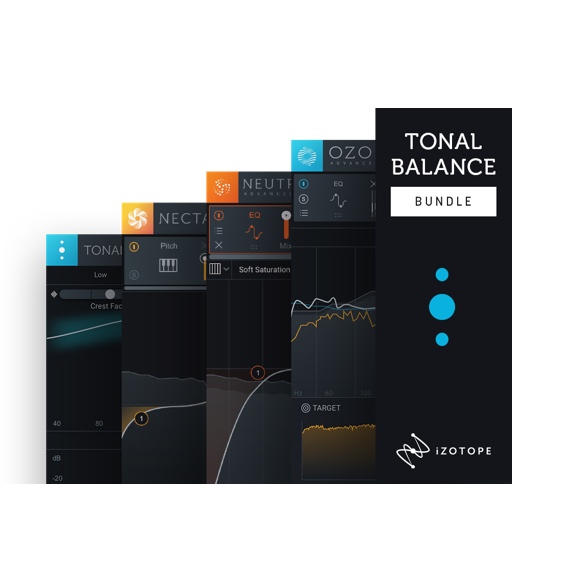Izotope Tonal Balance

IZotope Tonal Balance Bundle Software Bundle Get iZotope's top tools for production, mixing and mastering in one package: Nectar 3, Neutron 3 Advanced, Ozone 9 Advanced, Tonal Balance Control, and more! Rate and review this product. The Tonal Balance Bundle brings mixing and mastering into one interconnected workflow that will help you achieve a professional, polished sound. Use tools that talk to each other and assist you in every step of the mix, from achieving level balance to adding the finishing touch to your finished product. Tonal Balance Bundle includes Neutron 3 Advanced, Ozone 9 Advanced, and Nectar 3. Oct 05, 2017 In this video, learn how to use the Tonal Balance Control plug-in in Ozone 8 Advanced. Monitor the overall balance of your master, compare your master to target curves based on intelligent.
Oct 05, 2017 In this video, learn how to use the Tonal Balance Control plug-in in Ozone 8 Advanced. Monitor the overall balance of your master, compare your master to target curves based on intelligent. Tonal Balance Control. Tonal Balance Control puts decades of mastering expertise in your hands, letting you adjust your tracks to targets based on thousands of professional masters. In Ozone 9, we’ve updated Tonal Balance Control with faster performance, smooth metering, and more ways to communicate with other iZotope plug-ins across your. Oct 30, 2017 Crest Factor Izotope Tonal Balance. Hello - So I picked up the O8N2 Advanced bundle while it was on sale and have been using the Tonal Balance plugin on the master. I understand using your ears and trusting them. However I am sometimes needing things explained to me in order to grasp better. There is a parameter called crest factor and I have. Best of all, Tonal Balance Control can communicate with other iZotope plug-ins across your session. Use Tonal Balance Control to call up any instance of Neutron, Nectar.
The tonal balance of a song is how the various frequencies of the music relate to one another. Virtual dj software virtual dj pro 7 download mac. You’re not concerned with how each instrument sounds in the mix (that’s the job for the mixing stage); instead, you’re looking for an overall balance of frequencies within the hearing spectrum.
For the most part, a tonal balance consists of an even distribution of frequencies from 20 Hz to 10-kHz with a slight drop-off (1–2dB) from 10- to 20-kHz or higher. That’s great, you say, but what does that sound like? Well, listen to a number of great CDs, and you’ll hear it.
When you master your music, you want to constantly compare the sound of your song to that of other CDs whose sound you like.

When you adjust the overall tonal balance of your songs, listen carefully for frequencies that seem too loud or too soft. You can find these frequencies by listening to the instruments in the mix or by using a parametric EQ and sweeping the frequency spectrum.
To do this, set your Q fairly wide (0.6, for instance) and turn the gain knob all the way up. Start with the lowest frequency and slowly raise the frequency as the song plays. Adjust annoying frequencies by cutting them by a couple of dB to see whether your overall mix improves.
Follow these general EQ guidelines:
Izotope Tonal Balance Plugin
If your mix sounds muddy, add high frequencies (above 10 kHz) or cut low ones (200 to 400 Hz). Likewise, if your mix is too bright (common with digital recording), try reducing the frequencies above 10 kHz by using a shelf EQ or a Baxandall curve.
To use a Baxandall curve, use a parametric EQ and set the threshold at 20 kHz with a Q setting of about 1. This gradually cuts frequencies above around 10 kHz. You can adjust the Q to reach as far down as you want. Your EQ graph shows you what’s happening.
Use the same EQ adjustments for both the right and left channels. This keeps the stereo balance intact and doesn’t alter the relative phase between the channels. For example, if you add some bass frequencies (100 Hz, for example) to the one channel and not the other, you may hear a wavering or pulsating sound around this frequency that goes back and forth between the speakers.
If you used a multiband compressor on specific frequencies, you may need to make some EQ adjustments to them. Compression tends to mess with the frequency response.
If you need to adjust the EQ of certain instruments in the mix (the snare drum is buried, for example), note the overall effects of your adjustments on the rest of the mix. If your adjustments aren’t fixing the problem, go back to the mixing process and make your adjustments there. You’ll be glad you took the time to do this.
Any adjustments you make to the EQ during mastering impact more than just those frequencies; the adjustments alter the entire frequency spectrum and the relationship among all the instruments. So listen carefully as you make adjustments, and back off the additional EQ if you don’t like what you hear.
Free Tonal Balance Control Plugin
Some people check the tonal balance of their songs against that of their favorite CDs. You do this by recording a favorite-sounding song into your mastering program and taking a look at its frequency response by using a spectral analyzer.